Tooth eruption is the process by which a tooth goes through the gums and becomes visible in the mouth. The set of teeth is intended to cut and grind down food during meals. The eruption of the teeth is a process that begins when a child is still a baby, and continues on through childhood and the teenage years. A person will have two sets of teeth: baby teeth and later on permanent teeth.
Primary teeth
The following chart shows when the primary teeth erupt. They are also called baby teeth or decidious teeth. It is important to note that the eruption time varies from one child to another.
| Primary teeth | ||
|---|---|---|
| Upper Teeth | Eruption Time | Age of Loss of Tooth |
| Central Incisor | 7 to 12 months | 6 to 8 years old |
| Lateral Incisor | 9 to 13 months | 7 to 8 years old |
| Cuspid (canine) | 16 to 22 months | 10 to 12 years old |
| First Molar | 13 to 19 months | 9 to 11 years old |
| Second Molar | 25 to 33 months | 10 to 12 years old |
| Lower Teeth | Eruption Time | Age of Loss of Tooth |
| Central Incisor | 6 to 10 months | 6 to 8 years old |
| Lateral Incisor | 7 to 16 months | 7 to 8 years old |
| Cuspid | 16 to 23 months | 9 to 12 years old |
| First Molar | 13 to 19 months | 9 to 11 years old |
| Second Molar | 20 to 31 months | 10 to 12 years old |
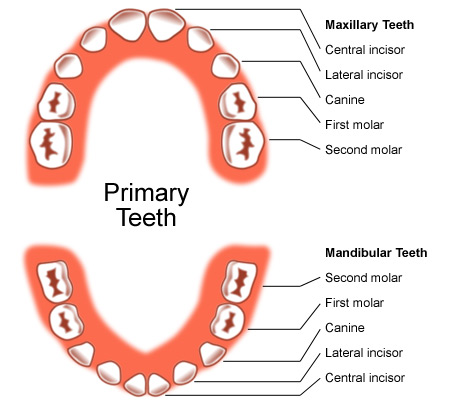
Some facts to consider
- Generally, tooth eruption occurs earlier for girls than for boys.
- Teeth erupt two by two, one on each side.
- Primary teeth are smaller and whiter than permanent teeth.
- Around the ages of two to three years old, primary teeth should all have erupted.
Signs and symptoms
There are signs and symptoms that can help recognize the eruption of teeth for babies:
- Irritation of the mouth.
- The baby placing objects or fingers in the mouth and biting on them.
- An increase of saliva in the mouth.
- Loss of appetite.
- Inflamed gums.
- General agitation.
- Redness on the cheek near the area where a tooth is erupting.
The tooth eruption process should not cause fever, vomiting, or diarrhoea. If these problems appear, it is important to consult a doctor.
To relieve the pain during tooth eruption:
- Use a clean finger to massage the gum.
- Use an anaesthetic cream sold in pharmacies (such as Orajel).
- Allow the baby to suck on a clean cloth moistened with cold water.
Permanent teeth
The following chart shows when the permanent teeth erupt. Some people also refer to them as adult teeth.
| Permanent teeth | |
|---|---|
| Upper Teeth | Eruption Time |
| Central Incisor | 7 to 8 years old |
| Lateral Incisor | 8 to 9 years old |
| Cuspid (Canine) | 11 to 12 years old |
| First Bicuspid (Premolar) | 10 to 11 years old |
| Second Bicuspid (Premolar) | 10 to 12 years old |
| First Molar | 6 to 7 years old |
| Second Molar | 12 to 13 years old |
| Third Molar (Wisdom Tooth) | 17 to 21 years old |
| Lower Teeth | Eruption Time |
| Central Incisor | 6 to 7 years old |
| Lateral Incisor | 7 to 8 years old |
| Cuspid (Canine) | 9 to 10 years old |
| First Bicuspid (Premolar) | 10 to 12 years old |
| Second Bicuspid (Premolar) | 11 to 12 years old |
| First Molar | 6 to 7 years old |
| Second Molar | 11 to 13 years old |
| Third Molar (Wisdom Tooth) | 17 to 21 years old |
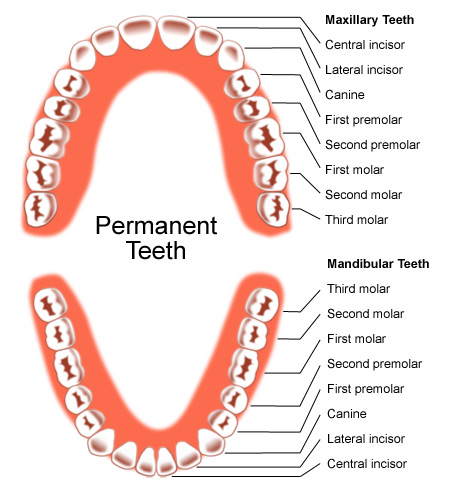
References
- Tooth eruption (Wikipedia).
- Dental Health and Your Child’s Teeth (WebMD).
- La dentition (Ma bouche en santé (Ordre des dentistes du Québec)).
The information above should be used as a reference only. Any medical decision should not be taken before consulting a health care professional.
The masculine gender may have been more used in the article, but without prejudice, to make reading easier.
Category: Children
- 5 reasons why baby teeth are so important
- 5 ways to provide the best dental care for your children
- Brushing children’s teeth
- Dental care for babies
- Early childhood tooth decay (baby bottle tooth decay)
- Easter tips for healthy teeth
- Grey teeth and tooth discolouration
- Hygiene and orthodontics
- Kids’ fear of dentists
- Nutrition for kids
- Thumb sucking
- Tooth eruption
- Your child’s first dental visit

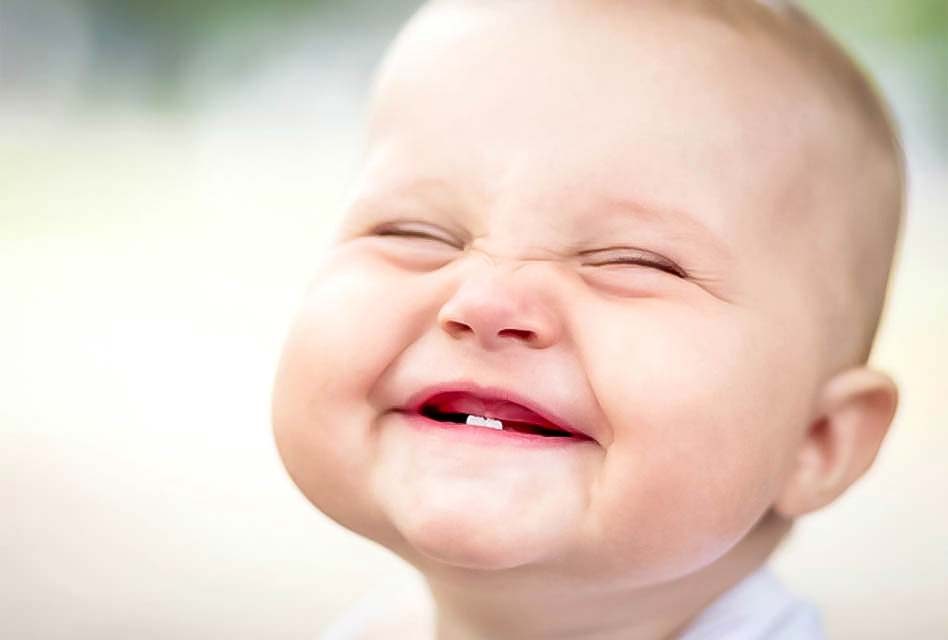
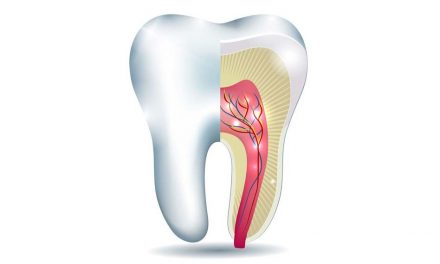
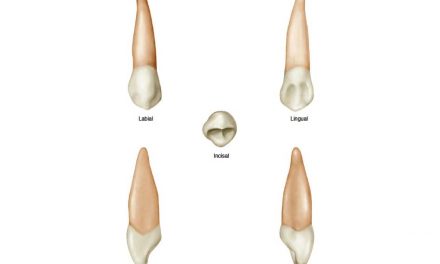
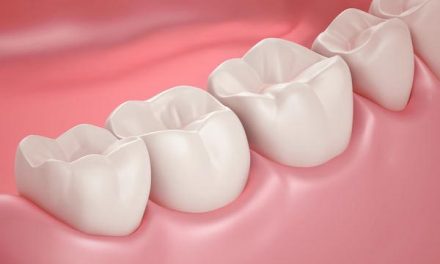
Hi please can you help me, my 8 year old son has both his permanent central Incisors and both his canines. I always wondered how the the lateral incisors were going to fit in as there is such little space for them. Only now I see on your chart that he was suppose to get his lateral incisors before his 2 canines. The problem is that it appears that his lateral incisors might be trying to come out, only it looks like they will be cutting through out the sides of the gums instead of straight because I think there is no space for them?!!
What is the procedure for such a thing? Please help, I will be taking him to the dentist but I would appreciate it if you could shed some light on this so I can be informed.
Thank you
Carmen
Hello Carmen, there are 2 possibilities:
1- that the lateral incisors are impacted because of lack of space (as you said). In this case orthodontics will be needed with possible palatal expansion before to create space; but when there is lack of space, it is more common that the canines stay impacted.
2- (most probable) that the lateral incisors don’t exist! This is often seen. Only an exam with possible x-rays can confirm it. In this case, if aesthetics are a problem, orthodontics with cosmetic work can be done in the future.
Hi my son is 11 has good teeth but complaining of pain when eating on his back teeth does that mean he’s going to loose his back teeth soon
The only way to confirm that is for a dentist to see your son and examine his teeth.
Hello doctor, my 11 year old son doesn’t have his permanent lateral incisors. Yesterday I found out that his right lateral incisor is loose. Is it possible that his lateral permanent lateral incisors are coming in?!
Thank you
Yes it is possible, although 11 yo is late for the permanent ones to come out. The permanent lateral incisors sometimes do not exist and the child remains with the baby ones. The best way to know is to see a dentist and to have front x-rays taken.
My 10 year old is cutting her permanent canines and the gums are swollen and she’s having headaches. Is headaches normal when cutting teeth? She also has three molars coming in as well.
Hello Mary, what do you mean by “cutting” as in your daughter is cutting her permanent canines? Do you mean they are coming out of the gums (tooth eruption)? If so, yes, but it’s better to have your dentist verify.